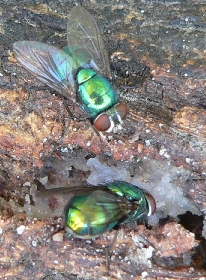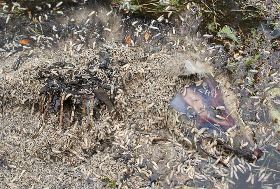Interactions
Provides food for other organisms:
 Lucilia sericata have many
interactions with other organisms in the environment. This fly
can be a possible meal for many different animals and even
certain plants. Some of these organisms that feed upon
Lucilia sericata include a
venus fly trap,red
eyes tree frog,or even a
dragonfly. Humans can even use the maggots of this organism to attract
animals. Fisherman will often use Lucilia sericata
maggots to catch
catfish and other types of fish.
Lucilia sericata have many
interactions with other organisms in the environment. This fly
can be a possible meal for many different animals and even
certain plants. Some of these organisms that feed upon
Lucilia sericata include a
venus fly trap,red
eyes tree frog,or even a
dragonfly. Humans can even use the maggots of this organism to attract
animals. Fisherman will often use Lucilia sericata
maggots to catch
catfish and other types of fish.
Used as an intermediate host:
A nematode called Syngamus
trachea (Gapeworm) is a parasitic worm that infects the trachea
of birds. This will cause respiratory distress in the bird that
can then cause death. This nematode can use the larvae of
Lucilia sericata as an intermediate host.
Turkeys and chickens are the most common birds that will
become infected with gapeworm.
Parasitic:
The summers can be
troublesome for the
sheep population because of Lucilia sericata. This
is commonly called fly strike, which is the infestation of sheep
by maggots. Flies will lay their eggs on the wet wool that is
usually contaminated with feces. Once the eggs hatch maggots with begin to feed on the surface of the skin and cause damage
to the sheep. The strike of Lucilia sericata can infect
up to one million sheep in just a year! Check out the website
called
strikewise that records daily temperatures and rainfall to
forecast the likelihood that these flies will strike sheep. Another
animal that this fly may strike an attack upon are rabbits.
with begin to feed on the surface of the skin and cause damage
to the sheep. The strike of Lucilia sericata can infect
up to one million sheep in just a year! Check out the website
called
strikewise that records daily temperatures and rainfall to
forecast the likelihood that these flies will strike sheep. Another
animal that this fly may strike an attack upon are rabbits.
Mutualistic:
Adult flies will often feed on flowering plants.
As the flies move from one flower to another this
creates
pollination. The flower can then reproduce and the fly feasts on a
nourishing meal. Both organisms will benefit from
the pollination. Check out
this Youtube video of a fly pollinating a
flower!
 Detritivores:
Detritivores:
Lucilia
sericata will use dead or decaying material to lay their
eggs. The eggs that hatch into maggots will then feed on that dead or decaying matter from which they were born.
dead or decaying matter from which they were born.
Now let's take a look at medical maggots